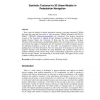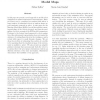42 search results - page 4 / 9 » A Cognitive Modeling of Space using Fingerprints of Places f... |
RAS
2008
13 years 7 months ago
2008
Task planning for mobile robots usually relies solely on spatial information and on shallow domain knowledge, like labels attached to objects and places. Although spatial informat...
TAMOCO
2008
13 years 9 months ago
2008
Since years the market of mobile navigation systems is growing enormously. Within this paper the goals and first results of the joint project "Mobile Navigation with 3D City ...
ICRA
2002
IEEE
14 years 16 days ago
2002
IEEE
In this paper we present a novel approach to mobile robot navigation in natural unstructured environments. Natural scenes can be considered as random fields where a large number ...
ATAL
2010
Springer
13 years 8 months ago
2010
Springer
Appearance-based localization compares the current image taken from a robot's camera to a set of pre-recorded images in order to estimate the current location of the robot. S...
ICRA
1993
IEEE
13 years 11 months ago
1993
IEEE
Navigationalpath planning is a classicalproblem in autonomous mobile robotics. Most AI approachesto path planning use goal-directedheuristicsearch of problem spaces defined by spa...


